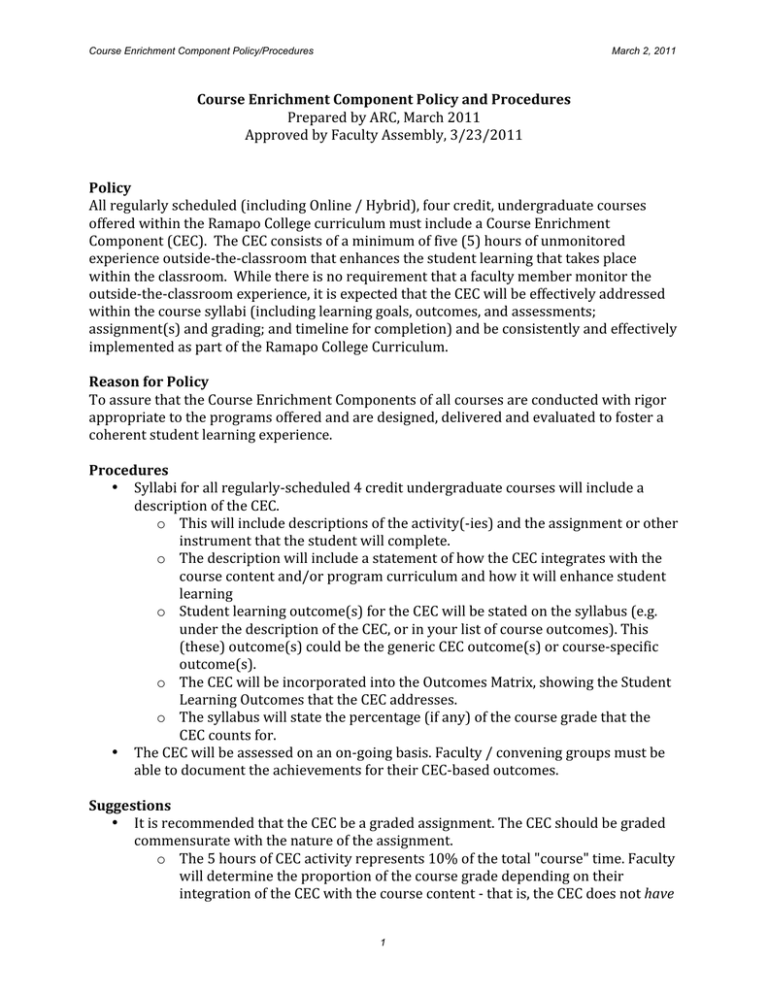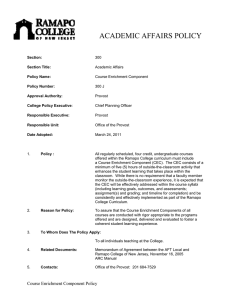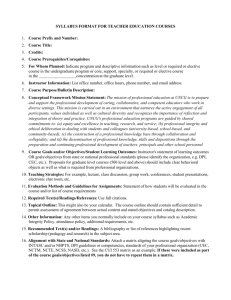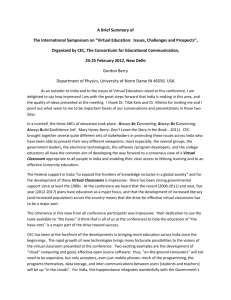Prepared by ARC, March 2011 Approved by Faculty Assembly, 3/23/2011 All regularly scheduled (including Online / Hybrid), four credit, undergraduate courses
advertisement

Course Enrichment Component Policy/Procedures March 2, 2011 Course Enrichment Component Policy and Procedures Prepared by ARC, March 2011 Approved by Faculty Assembly, 3/23/2011 Policy All regularly scheduled (including Online / Hybrid), four credit, undergraduate courses offered within the Ramapo College curriculum must include a Course Enrichment Component (CEC). The CEC consists of a minimum of five (5) hours of unmonitored experience outside‐the‐classroom that enhances the student learning that takes place within the classroom. While there is no requirement that a faculty member monitor the outside‐the‐classroom experience, it is expected that the CEC will be effectively addressed within the course syllabi (including learning goals, outcomes, and assessments; assignment(s) and grading; and timeline for completion) and be consistently and effectively implemented as part of the Ramapo College Curriculum. Reason for Policy To assure that the Course Enrichment Components of all courses are conducted with rigor appropriate to the programs offered and are designed, delivered and evaluated to foster a coherent student learning experience. Procedures • Syllabi for all regularly‐scheduled 4 credit undergraduate courses will include a description of the CEC. o This will include descriptions of the activity(‐ies) and the assignment or other instrument that the student will complete. o The description will include a statement of how the CEC integrates with the course content and/or program curriculum and how it will enhance student learning o Student learning outcome(s) for the CEC will be stated on the syllabus (e.g. under the description of the CEC, or in your list of course outcomes). This (these) outcome(s) could be the generic CEC outcome(s) or course‐specific outcome(s). o The CEC will be incorporated into the Outcomes Matrix, showing the Student Learning Outcomes that the CEC addresses. o The syllabus will state the percentage (if any) of the course grade that the CEC counts for. • The CEC will be assessed on an on‐going basis. Faculty / convening groups must be able to document the achievements for their CEC‐based outcomes. Suggestions • It is recommended that the CEC be a graded assignment. The CEC should be graded commensurate with the nature of the assignment. o The 5 hours of CEC activity represents 10% of the total "course" time. Faculty will determine the proportion of the course grade depending on their integration of the CEC with the course content ‐ that is, the CEC does not have 1 Course Enrichment Component Policy/Procedures March 2, 2011 to be worth 10% of the course grade (for instance, it could be worth 0%, or 100%). o It is recommended that failure to complete the assignment should be treated in the same manner as failure to complete any other assignment in the course. Failure to complete this mandatory component should not, generally, result in a grade of F for the course. o Remember it must be assessable • Courses with co‐requisites, and programs in which students are ‘bundled’ into courses (e.g. first semester freshmen), may desire to establish a single larger CEC that serves these grouped courses. Courses exempt from the CEC: The CEC does not apply to: • Independent Studies, co‐ops and internships; • courses bearing fewer than 4 credits; • graduate level courses; • laboratory science courses or any other courses with scheduled meeting times in excess of 50 hours per semester. Additional Information • The Design Team will develop student learning outcomes for the CEC. • The Design Team will coordinate the development of information dissemination including Best Practices, workshops, etc. • The ARC manual contains language to be incorporated into syllabi. • The February 2011 report of the Design Team includes a summary of the Fall 2010 faculty survey, and numerous additional recommendations regarding the CEC. • The ARC and Design Team remind faculty that the CEC is integrated in the course. Many possible models exist. The CEC can be a graded assignment, but must be assessable; course requirements for students (and grading for faculty!) should be planned accordingly. Background Information • The CEC is a required component of all 4‐credit undergraduate courses. • A four credit course is required to meet for a minimum of 50 hours per semester1; however, the faculty course load reduction implemented in Fall 2006 results in classes meeting for only 45 hours per semester (the equivalent of 3.6 faculty credits). The five hour CEC makes up the difference. • Because faculty are contractually obligated for 3.6 credits rather than 4 credits, the CEC is "unmonitored" ‐ i.e., faculty are not required to be present during the five hours. o However a faculty member may choose to monitor the CEC, for instance by leading a field trip. o There are no specifications as to whether the CEC should be graded or not. Original Definitions 1 Academic Issues Committee Manual 20101‐2011, New Jersey Presidents' Council. 2 Course Enrichment Component Policy/Procedures March 2, 2011 "Extra Class Activity ‐ To facilitate College efforts to significantly enhance teaching and learning without excessive costs to the College, the faculty will incorporate into the syllabus and class instruction extra class activity opportunities, such as participation in convocation, colloquia, seminars and guest speaker programs. Such extra class activity will be incorporated into the curriculum after consultation with the Convening Group and Dean." AFT Memorandum of Agreement 11/16/2005 Experiential Component: "[e]ach course will include five (5) hours of unmonitored appropriate experience outside the classroom over the period of the semester. These experiences, which enhance student learning, could include visits to museums, guest lectures, library programs, colloquia, assigned TV shows, movies, participation in class projects, service learning, convocations, trips to professional meetings, and a wide range of other activities limited only by the creativity of our faculty and students". AFT Memorandum of Understanding 11/16/2005 Incorporated verbatim into ARC Academic and Curricular Guidelines Manual 3 Learning Goal and Measurable Student Learning Outcomes for the Course Enrichment Component ARC and Design Team, March 23 2011 Approved by Faculty Assembly, 4/13/2011 Goal: Each student will participate in five or more hours of unmonitored experience(s) outside the classroom designed to enhance student learning in the course. Outcomes (All courses should include one or both of these outcomes, as appropriate) ‐ Demonstrate how an out‐of‐class activity applies knowledge obtained in the classroom o The activity would be a hands‐on / minds‐on activity, e.g. fieldwork, lab‐type activity, creative work, etc. o Examples of Instruments (assignments): a lab / field report; embedded question(s) on exams; research material incorporated into existing paper as a source; oral presentations/reports; creative works. ‐ Demonstrate how your learning of the course material is connected to and enhanced by the out‐of‐class activity o Examples of Instruments: reflection paper; embedded question(s) on exams; research material incorporated into existing paper as a source1; oral presentations/reports 1 E.g. assignments where students conduct interviews outside of the classroom, and use those interviews as primary sources





